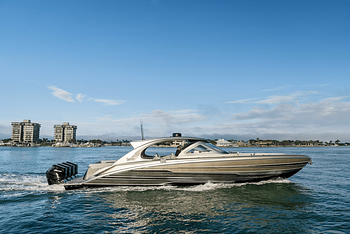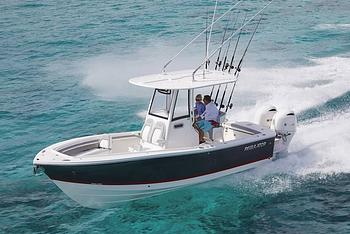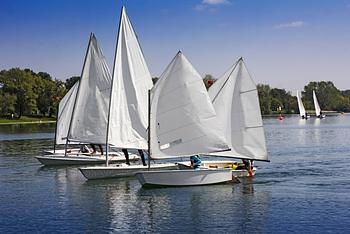The man has always wanted to conquer the seas, to explore beyond the horizon. Yet dangers and hardships awaited the intrepid. Thankfully for us, boats have come a long way, and today the luxurious world of recreational boating is very comfortable and safe indeed. Through the centuries, there have been many incredible inventions which have changed the face of the #boating world, from celestial navigation to square wine bottles.
Here we take a look at some of the greatest inventions that changed the boating world:
1 – Deep V Hulls
When it comes to recreational boating, the invention of the deep-V hull by C. Raymond Hunt in the 1950s has had one of the biggest impacts in the industry – both on marine architecture and boater’s bottoms. The smoother ride at high speeds is, however, just one of the attributes of the deep-V hull. An even distribution of displacement and flaring topsides have created a drier and safer boat.
Check out our range of sports boats, power boats, sports cruisers here!
2 – Magnetic Compass
The oldest innovation on our list and something which changed the maritime world forever is the magnetic compass. Historians believe that the very first magnetic compasses date back to the Chinese some 2,000 years ago, but it wasn’t until the 12th century that Western Europeans began using them to navigate. The design may have changed over the years – the evolution of iron and steel ships affected the compass readings and adaptations were made - but the principle remains the same, which in our technological world is an incredible feat. All hail magnetic north and the compass.
3 – Screw Propeller
Whichever way you spin it, Sir Francis Pettit Smith’s invention was game-changing in the boating world. While the idea of using the Archimedean screw for propelling a ship had been floated since the 17th century, the prototypes were manually turned. Enter British-born Smith in 1836 and his invention of a steam engine and propeller with a driveshaft. His invention came just six weeks before his engineering rival, Swedish John Ericsson, but in the spirit of science, the two men worked alongside each other to introduce screw propellers on war vessels in the UK and US.
4 – Anti-fouling paint
Even though Charles Darwin fine-tuned his ideas on speciation through years of studying barnacles he wasn’t so keen on them clinging to the bottom of HMS Beagle. So he, like the rest of the fleet, nailed sheet copper on the bottom of wooden boats because of its toxicity to marine life. During the 1880s copper-based antifouling paints were developed, followed a few decades later by even more potent coatings using tributyltin (TBT). While the dangers of encrusted hulls were in effect solved, it did come at a great cost with the poisoning of marine ecosystems. Today the search is on for a more eco-friendly solution. Let’s hope we have another great innovation to add to our list soon.
See our collection of beautiful wooden boats for sale.
5 – Fibreglass
Ancient civilisations may have been making a form of fibreglass centuries ago, but what we know as fibreglass today was the result of a lucky accident in 1933 by Dale Kleist, a researcher for Corning Glass, who inadvertently discovered an easy way to make fibreglass. Corning Glass and Owens-Illinois together patented it in 1936, and the company Owens-Corning is still operating today. Fast forward to 1942 and the first fiberglass recreational boat built by Ray Greene. Greene founded a sailboat company and built 175 25-foot yachts. The rest, as they say, is history.
Explore our wide range of fibreglass boats, including sailing yachts and power boats.
6 – Nylon Ropes
The next time you haul in your lines, thank the DuPont Company for inventing nylon in the 1930s. Otherwise you, like mariners before you, would be laying the anchor and lines out on the dock to dry after every voyage to prevent them from rotting. Nylon was first used commercially as toothbrush bristles in 1938, but the applications for other industries were quickly realised. Ropes were first made from tough, rot-resistant nylon during World War II, and while other synthetic fibre materials have since been discovered, nylon was the one which got the ball rolling.
7 – GPS
We can thank the U.S Department of Defense for inventing a reliable way to find the position of your boat on the open ocean without having to use celestial navigation and paper charts. Global Positioning System (GPS) was designed in the 1970s for military use, but the application for civilian use quickly became apparent. By 1994 the GPS satellite constellation was declared fully operational, and within a short time boat were being equipped with units. Now it is possible to know your position in the middle of the blue, anywhere in the world, in any weather. This surely ranks as one of the top innovations in maritime history.
8 – Inflatable Life Jackets
Life jackets are boating essential and have saved thousands of lives over the years. Known as personal flotation devices (PFDs) they were made from all manner of ingenious materials, to begin with – from inflated animal bladders to inflexible cork. It wasn’t until 1928 however that Peter Markus invented the first inflatable life jacket which was widely used in World War II. It was nicknamed the Mae West in a cheeky nod to the famous actress’ physical appearance. Today, there are hundreds of styles and designs of PFDs – there are even ones for pets!
See our guide to Keeping Your Family Safe Onboard.
9 – Sonar and Radar
Using more than the naked eye to navigate the oceans by has to be one of the boating world’s greatest inventions, and changed the face of yachting forever. Sonar, used to detect the water depth and bottom contours, was used during World War II by submariners, but it wasn’t until 1959 that it was manufactured commercially for recreational boaters. Radar too had navy origins. It was developed by the U.S Navy in 1934 and was, 20 years later, rolled out to recreational boaters.
10 – RIB (Rigid Inflatable Boat)
While the Phoenicians and Assyrians used inflated goat’s bladders as boats centuries ago, the modern-day RIB owes its origins to the 20th century and the failed airship industry. With accidents on the rise French manufacturer, Societe Zodiac turned to air-filled rubber boats and, in 1934, invented inflatable catamarans. A floor was soon attached between the rubes and so was born the Zodiac. In Britain, the Royal National Lifeboat Institute (RNLI) saw the potential of these robust and hard-wearing crafts, and the first production RIB was showcased in 1969. Renowned for their ability to tackle adverse weather conditions and big seas, the RIB has certainly been one of the biggest innovations to change the boating world.
Check out our huge range of RIBs for Sale
10 – Motion Sickness Medication
Seafarers have suffered from seasickness (or motion sickness) for as long as there have been boats. It is said even Columbus and his men were struck down by it. For centuries mariners relied on folk remedies until World War II efforts to find a cure to what was a hindrance to the war effort was discovered. It was found antihistamines were effective, and Scopamine was developed in the UK with Dramamine being produced in the US a couple of years later. Today these medications allow everyone to get out and enjoy boating, even those who go green around the gills.
See our range of catamarans for sale, which is renowned for their stability and favoured by those who are affected by seasickness.
Related Articles and Guides
19th Jul 2024
The World’s Best Yacht Brands
12th Jul 2024
Top Performance-Boat Brands, Where There’s Something For Everyone
28th Jun 2024
Best Center Console Boats: The Best Brands Across the Spectrum
23rd Jun 2024






